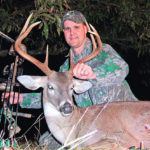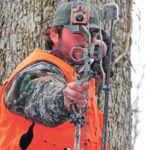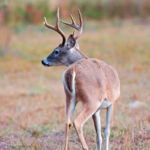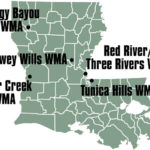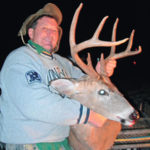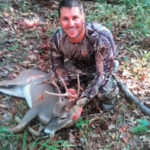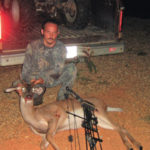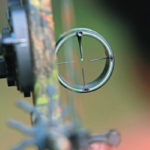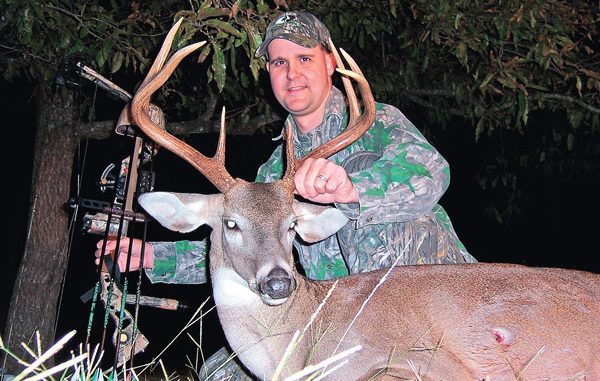
Tote your bow to any of these WMAs, and you won’t care for one moment that you don’t have a high-dollar lease.
Louisiana deer hunters can get a little pugnacious when somebody starts talking about how good deer hunting is at their local wildlife management area. No matter how long their laundry list of logic may be, it mainly boils down to them not wanting any additional hunting pressure where they frequently hunt.
I can understand that. After investing so much time and money to find a good spot at a tract of public hunting land, I wouldn’t want a bunch of boors be-bopping under my stand at first light trying to find a spot they had just read about in a magazine.
But let’s face it, public hunting areas are just that — public. That means anybody can use them anyhow they see fit as long as they are doing so within the rules and regulations put out by the Louisiana Department of Wildlife and Fisheries.
You don’t like that? You want it all to yourself?
Well, as my late father-in-law was fond of saying, “Want in one hand and poop in the other and see which one fills up first.”
If you don’t like that your public-land hunt might be ruined by a bunch of yahoos, your only options are to buy private land, lease land from somebody else, join a hunting club or figure out a different way to deer hunt Louisiana’s WMAs.
One different way of hunting that Louisiana’s public-land deer hunters may want to explore is bowhunting during the state’s early archery season. Depending on which WMA you hunt, the advantages of bowhunting public land before the gun hunters come out range from less pressure to easier-to-pattern deer to pre-rut buck movement.
Bowhunting during the early archery season at WMAs might not be effortless, but it’s about the easiest chance you’re going to get all year long to bag a deer with your bow on public land.
Which WMAs should you hunt for the best chance of early archery season success? I put that question out to the wildlife biologists that are responsible for overseeing public land all across Louisiana. Here’s how they responded.
Clear Creek
Wendell Smith, biologist supervisor for the Lake Charles LDWF office, pointed out that Clear Creek WMA in Vernon Parish is a good tract of public land where bowhunters can score in the early archery season.
“It has 53,000 acres,” Smith said. “The deer herd is very healthy, and fawn production averages 1.5 fawns per female.
“Deer weights have remained steady for the past few years, which was attributed to reducing the herd below the carrying capacity each year. We had a total of 403 deer harvested last hunting season with an overall success ratio of 1 deer per 18 efforts.”
Bow season actually starts in September when high temperatures suppress deer movement somewhat, but Smith says that deer really start moving by the end of September.
“Peak pre-rutting behavior will begin the second week of October,” he said. “The peak rut will occur the last week of October through the second week of November.
“All of Clear Creek gets hunted, but fewer people are in the woods during bow season as opposed to gun season — no problem finding a place to bowhunt and not be disturbed by another hunter.”
Hunters tend to gravitate to the creek bottoms, but backing off these areas and hunting clear cuts and bottom transition zones can also be successful. Last archery season, there were 33 bow kills from 2,160 efforts, and you can bet those 33 hunters didn’t just show up to hunt.
“Bring lots of water and stay hydrated,” Smith advised, “and do your homework. Have a map of the area on hand when you’re scouting, and keep a GPS with you to mark waypoints of promising areas.”
Loggy Bayou
Jeff Johnson, biologist supervisor for the LDWF Minden office, singled out Loggy Bayou WMA just south of Lake Bistineau in Northwest Louisiana because there has been very little pressure on this herd for the last two seasons.
“In 2009, we had major flooding during hunting season, which damaged the bridge that accesses the majority of this WMA,” Johnson said. “That made hunting very limited with access primarily by boat.
“A new bridge was under construction during the 2010 season, which again made for very limited access to the majority of the WMA.”
Although limited access reduced hunting pressure for the past two seasons, it also means there hasn’t been a managed hunt on Loggy Bayou since 2008. That means Johnson doesn’t have a lot of current physical data on the deer population.
“That being said,” he continued, “the herd appeared in good shape in 2008, and all indications based on what we have seen, such as sightings and browsing, point to a healthy herd that is still in balance with the available habitat. It’s likely nearer carrying capacity than it was in 2008, but it’s still in balance at this time.”
Of the 41 deer killed at Loggy Bayou last year, seven were killed by bowhunters. Those numbers might not look too good, but Johnson reminded that hunters were limited to accessing the WMA by boat or two walk-in areas. In 2008, the last year there was no access problems, the total deer harvest was 153.
Johnson suggested bowhunters look for travel routes between bedding areas and food sources. He expects the deer will primarily be browsing when archery season opens, which might make them a little more difficult to pattern.
However, once the acorns start falling, hunters will fare better by setting up on the food source itself. And then if you were having trouble seeing deer during the daytime hours, move back to the trails to get a better look at them before dark on their way to the acorns.
“If you see a deer you want to harvest on Loggy Bayou, make your shot count and harvest that deer,” Johnson said. “In other words, if you’re not a trophy hunter, don’t start second guessing yourself about what is coming down the trail next.
“Don’t get caught up in killing a bigger buck if that’s not your thing. An adult doe is also a trophy when bowhunting, and harvesting them helps more to manage the deer herd than does passing her up and waiting on a buck.”
Dewey Wills
LDWF biologist Steve Smith says all indications are that the deer herd at Dewey Wills WMA just south of Catahoula Lake is staying below the carrying capacity, which is what he wants. Hunters killed 22 deer last archery season based on the self-clearing permit system, and Smith pointed out that of these 22 deer, he saw a two-to-one doe-to-buck ratio.
“There is very little pressure during archery season,” said Smith. “With 65,000 acres of bottomland hardwoods, there is plenty of room to scout and hunt without encountering another hunter.
“Use increases during gun season, but there is still plenty of room to bowhunt.”
Because rutting activity doesn’t begin showing up until the middle of November, the rut is not important at all for early season archery hunters. Smith says the key to early season success is to put in a lot of foot time.
“Walk, walk, walk until you find the sign you want,” he suggested. “In early bow season, encouraging sign can be difficult to find just anywhere.
“The deer are there, but the sign just doesn’t show up like it does later in the season when rutting activity is taking place. The best sign shows up at trails in wet areas and under the right oak trees.”
Smith cautioned that bowhunters should be prepared for a fairly dense understory over most of the WMA, and that they should be ready to move when a food source plays out.
“There is also a lot of area — approximately 20 percent — that is accessible by boat only if you like to hunt that way,” Smith said. “Those areas tend to produce good deer.
“However, we routinely see good deer coming from the road and trail accessible areas as well.”
Red River/Three Rivers
These two neighboring WMAs combine to form 68,970 acres of tremendous early season archery hunting. According to LDWF Biologist Supervisor Jonathan Bordelon, the deer herd is in great condition.
“Deer habitat demonstrates low to moderate utilization depending on the site,” he said. “Basically, the deer are not overbrowsing the available plants, but they are moderately utilizing many of the preferred browse species.”
Bordelon has documented moderate to high fat levels on deer collected through herd checks, and the same research revealed an average of 1.6 fawns per doe. Deer are within the carrying capacity of the habitat, and some of the heaviest deer to be harvested on public lands come from Red River WMA and Three Rivers WMA.
Of the 37 deer recorded as archery kills on the self-clearing permits last season, 20 were harvested during October. The tremendous size of the WMA complex allows hunters to find solitude during the archery-only segment of the season.
“Timber management over the past decade has created areas of great deer habitat from the standpoint of browse availability and cover,” Bordelon said. “Many of the areas of recent timber harvest are not appealing for small-game hunters, so they provide sanctuaries for archery hunters attempting to escape hunting pressure.”
During October, Bordelon expects deer will still be targeting browse. Some soft mast may be available, including persimmon, but most of the hard mast will begin dropping well into the season.
“Deer will target any soft mast,” Bordelon said. “Deer will hit the honey locust pods early in the season once they begin falling.
“This is always a common food found in stomachs during November. And late-dropping persimmons can provide reward as well.”
Bowhunters should avoid heavily canopied areas with little to no vegetation on the ground. These oak flats may be great areas late in the season if hard mast is present, but early season hunters should stay away until the hard mast drops.
“Know your target, too,” Bordelon said. “Both feral hogs and black bears are found on Red River WMA and Three Rivers WMA.”
Tunica Hills
Biologist Supervisor Christian Winslow pointed out Tunica Hills WMA in West Feliciana Parish as being a good one for early season bowhunters to target. During the 2010 – 11 season, hunters killed a total of 139 deer, 66 of which were killed by bowhunters out of 2,008 total archery efforts.
“The early archery season offers bowhunters less pressure prior to the primitive-weapon season, which opens after Thanksgiving,” said Winslow. “And the key to early season archery success is to hunt the heavily used trails and travel corridors on the area.
“As the season progresses, focus your attention on the mast-producing trees.”
Winslow also pointed out that the northern tract of the WMA usually receives less hunting pressure and that hunter success tends to be higher in this area.
Commit to hunting hard-to-reach spots
One of the questions I put to these five LDWF biologists supervisors was if there were any parts of their selected wildlife management areas with good populations of deer that didn’t receive as much bowhunting pressure or that were especially good in the early part of archery season.
“That’s a pretty easy one,” said Jeff Johnson at the Minden office. “Basically a hunter can look at a WMA map and see the areas that appear to be more difficult to access. If it is harder to get to, odds are the pressure is going to be lower.”
No matter which WMA you choose to bow hunt this season, your chances of bagging a big buck go way up if you hunt where others are less apt to go. The convenient and obvious spots load up with hunters faster than the hard-to-reach spots.
